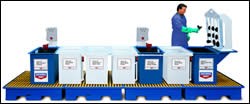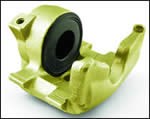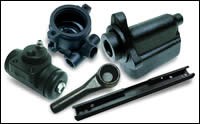Part Finishing And The New RoHS And ELV Directives
New environmental directives that have come out of Europe and Asia limit the toxic chemical content in manufactured products in order to protect users and to facilitate the recycling of these components. Restriction of Hazardous Substances legislation limits hazardous metals contained in electrical and electronic components. The ELV (End-of-Life Vehicle) Directive limits polluting metals that can be contained in vehicles in order to minimize hazards caused by recycling their components. In order to comply, manufacturers will have to consider finishing processes such as a low-temperature black-oxiding process that does not use banned substances or leave them in the finished product.
Share




If you manufacture plated metal components that are sold in Europe or Asia, better take heed. The RoHS and ELV directives take effect in 2006. Many traditional plated finishes do not comply; the alternatives may cost more to apply and may offer questionable performance.
What Are RoHS And ELV?
New environmental directives that have come out of Europe and Asia in the last few years are primarily aimed at the electronics and automotive industries. The purpose of these directives is to limit the toxic chemical content in manufactured products in order to protect the user and to facilitate the recycling of these components. The focus of the RoHS (Restriction of Hazardous Substances) legislation is to limit the amount of hazardous metals contained in electrical and electronic components. The ELV directive (End-of-Life Vehicle Directive) limits the amount of polluting metals contained in vehicles in order to minimize the pollution hazards caused by the recycling of their components. See Figure 1. Traditional plated finishes and certain conversion coatings often contain elements that do not comply with these directives, or are of questionable value, and should be re-examined.
Exploring this legislation in a bit more detail makes the connection with metalworking manufacturing clearer. In a nutshell, the RoHS Act restricts the content of certain toxic materials in electric/electronic components. The list includes lead, mercury, hexavalent chromium, cadmium and certain organic compounds. The organic compounds listed are mainly used as dielectric materials in high voltage transformers and affect just a few manufacturers. However, the other metals are more prevalent than you might guess, and are often used in common protective coatings.
In a similar manner, the ELV Directive is primarily aimed at hexavalent chromium content in automotive components. Hexavalent chromium is a known carcinogen and a pollutant that is targeted for elimination all around the world. When car components are recycled, or re-smelted, to make new steel, the hexavalent chrome content presents a huge pollution challenge. Since it is only marginally soluble in the new steel alloys, it separates out in the form of slag, or sludge, in the smelting operation, and must be disposed of in an approved manner that adds huge costs to the operation. Oddly enough, chrome-plated parts are not a problem because metallic chromium is a useful alloying element in steel and blends right in without pollution issues. It is only the hexavalent form of chromium that is a problem.
The goal of both pieces of legislation is to restrict, or eliminate, the use of hazardous materials in manufactured goods sold overseas. Where are these metals used in the manufacturing process? There are three primary areas:
1. Zinc plated components. Zinc plating is widely used to enhance the appearance and corrosion resistance of many manufactured parts. See Figures 2 and 3. When properly applied, it is a proven performer that effectively protects the steel substrate through galvanic action. What may not be obvious, however, is the fact that all zinc plating is top coated with a chromate coating that adds brightness to the zinc deposit and protects it from premature corrosion. Chromate coatings are available in four grades: clear, yellow, olive drab and black—all of which have traditionally been based on hexavalent chromium. A known carcinogen, it has been targeted for elimination for many years for pollution-related and health reasons. The RoHS and ELV Directives add extra pressure to eliminate this material from use. There is a replacement for hexavalent chromium—a related compound called trivalent chromium. The trivalent chromium can be used in essentially the same manner as hexavalent chromium, but its salt spray resistance is significantly lower and its cost is significantly higher. Some platers compensate for this by top coating the trivalent chromate with a clear polymer coating, which does add protection, but also adds thickness and more cost. And, though the trivalent form is easier to deal with than hexavalent, it is still a regulated metal that requires specialized waste treatment when the metal parts are recycled or re-smelted. At the end of the day, many users might be tempted to say: “Trivalent Chromium is still chromium.” In other words, the trivalent form is only a partial fix for the problems that are present with this type of finish. Though less hazardous and less regulated, it may be only a matter of time before the trivalent chromium is also targeted for elimination.
2. Electroless nickel plated components. In a similar manner, electroless nickel plating has been popular in the metalworking industry, typically used on parts requiring a higher level of sales appeal. If you consider zinc plating to be a “utility” grade of plating used primarily for rust protection, then electroless nickel would be more of a “glamour” finish, used primarily for sales appeal. What is not obvious is that most traditional electroless nickel deposits contain small amounts of lead and/or cadmium as brighteners or leveling agents. Though nickel itself is not a target of RoHS or ELV, the lead and cadmium are definitely prohibited.
As is seen with zinc plating, there are alternatives to the lead and cadmium-containing deposits. Many of the newer versions of electroless nickel are formulated to be free of these materials. However, as before, the appearance and protection may not be as good and the costs are often significantly higher.
3. Black oxided components. Though black coatings do not normally contain metals listed in the RoHS or ELV Directives, they may contain other metals that are regarded as pollutants when parts are re-smelted or recycled. These can include: copper, selenium, nickel or other metals that serve as accelerators or reaction modifiers in the blackening solutions. So, even many black finishes can present a RoHS or ELV dilemma.
Outsourcing Means Further Complications
Outsourcing part finishing has long been a preferred technique to avoid the hazards of owning a polluting coating line and operating it in-house. Many manufacturers have traditionally avoided dealing with harsh chemicals and complicated finishing processes by simply jobbing out this work. With the new compliance requirements, outside vendors who provide the final part finish will be forced to share responsibility for compliance or lose this business. Outside vendors may also need to change their processes to meet the new mandates. In many cases, this may require capital equipment changes, training in the new processes and added monitoring to ensure compliance.
All of these areas of concern represent potential problems for manufacturers because they create uncertainty in terms of assuring the quality and compliance of the products being produced. At a time when most manufacturers are trying to energize their product sales to overseas markets, these new directives have the potential to derail much of their efforts. It is important for manufacturers to evaluate their part finishing situation as soon as possible, and identify options that they know are in compliance.
Other Compliance Options
Suitable options are those that can be used by outside platers on jobbed-out work, and can also be safely used with in-house process lines to finish precision manufactured components. One such option that fits this description is the Tru Temp low temperature black oxide process, from Birchwood Casey (Eden Prairie, Minnesota). This process is designed specifically to provide excellent protection and an attractive appearance to finished parts, and also comply with RoHS and ELV directives. Parts with this finish are shown in Figure 4.
Composed of a non-toxic iron oxide compound, this black oxide finish contains no chemicals that are regulated in any way, whether by RoHS, ELV or the U.S. Environmental Protection Agency (EPA). The finish offers a pleasing black appearance and salt spray resistance that matches, or exceeds, that of conventional high temperature black oxide finishes and cold black finishes. It matches the protection of most of the zinc plating on the market. The chemical solutions used in the process contain no EPA-regulated metals. Process rinse waters are normally allowed in sewers as a non-hazardous discharge and most installations require no waste treatment of any kind. In addition, the process is considered to be a safer alternative to most other finishes, such as hot oxide, cold blackening, zinc plating and black phosphates.
The process can be installed in almost any plant setting. It is safe and can be operated by personnel with no prior metal finishing experience. See Figure 5.
With today’s ever tightening regulatory environment, manufacturers are under greater pressure to modify and improve their products and facilities to come up to compliance. Good communication and planning can help to mitigate the potential effects of these new regulations and keep manufacturers on the road to profitable sales.
About the author. Mark Ruhland is vice president of Birchwood Casey.
Read Next
5 Rules of Thumb for Buying CNC Machine Tools
Use these tips to carefully plan your machine tool purchases and to avoid regretting your decision later.
Read MoreBuilding Out a Foundation for Student Machinists
Autodesk and Haas have teamed up to produce an introductory course for students that covers the basics of CAD, CAM and CNC while providing them with a portfolio part.
Read MoreSetting Up the Building Blocks for a Digital Factory
Woodward Inc. spent over a year developing an API to connect machines to its digital factory. Caron Engineering’s MiConnect has cut most of this process while also granting the shop greater access to machine information.
Read More






























.jpg;maxWidth=300;quality=90)








